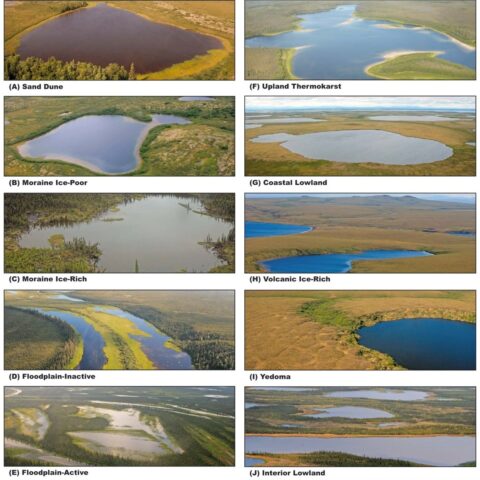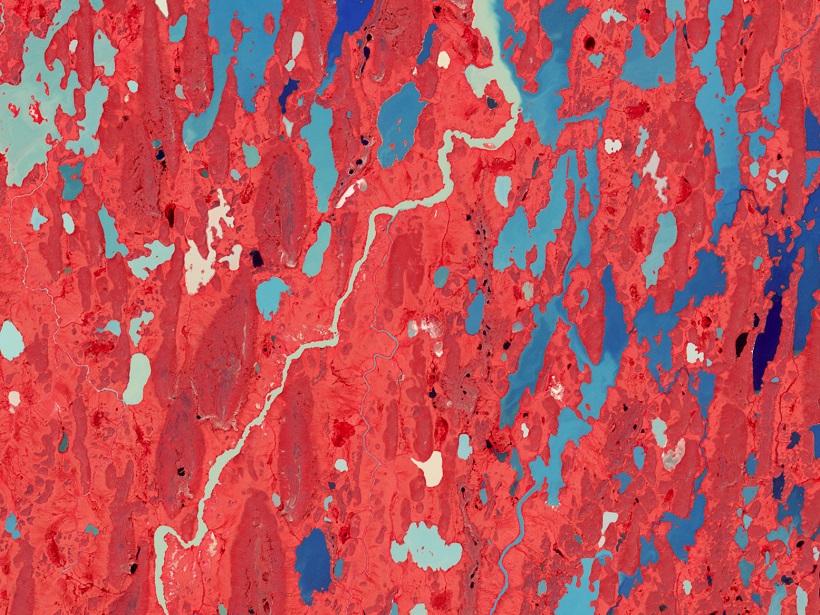Permafrost—subsurface soil that remains frozen year-round—covers nearly 19 million square kilometers of the circumpolar Arctic and is thought to contain around 1700 billion tons of organic carbon [Schuur and Abbott, 2011]. However, there is high risk of permafrost thaw under projected anthropogenic climate change.
The general processes that would lead to thaw of this vast carbon store are well understood. Increase in length of above-freezing air temperatures leads to boost in microbial activity and release of carbon. Significant releases could promote a vicious cycle, as higher atmospheric carbon dioxide (CO2) enhances anthropogenic warming. What’s less well understood are abrupt changes, the accuracy of predictive models, and requirements for long-term monitoring [Schuur et al., 2015]. The processes of carbon release are intertwined with multiple factors, including microbial community composition, stability of old carbon, physical soil structure, and relative fraction of leaching to atmospheric emission.
Because this event signifies potential large carbon cycle feedbacks, the Arctic has become a region of intense scientific study in recent years. Scientists expect the top three meters of permafrost is likely to thaw by the end of this century [Schuur and Abbott, 2011] but significant uncertainties remain on timing, magnitude, and mechanisms. Journal of Geophysical Research-Biogeosciences and other journals have seen a number of papers published recently that shed significant new light on many features of this dramatically changing landscape.
Monitoring: the surprising role of winter
A growing number of papers are demonstrating the importance of monitoring permafrost dynamics not just in the warm summer season but in the winter as well. Celis et al., 2017 combined six years of eddy covariance flux tower data and soil respiration chambers and found that a moist tundra site was a source of carbon to the atmosphere, but much of the net source arises from the slow, but continuous emissions in winter. Winter emissions offset nearly 30% of summer uptake. Similarly, a study by Pirk et al. [2016] in Greenland and Svalbard showed high concentrations of CO2 and large sources of greenhouse gasses occurring in soil cracks throughout winter.
Logistical challenges make in situ monitoring in winter challenging. However, recent advances in technology offer promising methods to better monitor spatial variation that influence these carbon emissions and thaw rates. For example, Dafflon et al. [2017] demonstrated in a polygonal tundra how soil electrical resistivity tomography and vegetation activity cameras can be merged with in situ measurements in a way to corroborate the role of active layer thickness and polygon geometry on spatial control on productivity, and demonstrate how changes in solute concentration and unfrozen water content in winter contributes to acceleration of permafrost thaw. Unfrozen water persists into the winter, at depths as high as three meters.
Leaching: a significant pathway
Beyond monitoring directly within or above the permafrost, another set of papers have pointed to the role of leaching and export via streams and groundwater to lakes as a significant source of carbon transport in thawing permafrost. Zhang et al. [2017] conducted lab experiments of leaching and found dissolved organic carbon (DOC) export of nearly five per cent of the carbon stored in surface soils. Deeper, older soils showed greater selectivity in which compounds were released or stored.

One pathway for leached DOC to release CO2 is photooxidation. Stubbins et al. [2017] used irradiation experiments and radiocarbon dating and found that photooxidized DOC was nearly always modern DOC, though sunlight-driven photomodification was present in both young and old carbon.
Some fraction of DOC is also exported to lakes, where it may be released of CO2 or methane (CH4), depending on available oxygen in the water column.
Larsen et al. [2017] provided one of the first detailed characterizations of these lakes across the region as a function of permafrost characteristics (see images).
Prediction: tradeoffs with land cover change
Ultimately, the long-term fate of carbon release from thawing permafrost may be counterbalanced by enhanced vegetation growth. By using dual radioactive tracers with differing lifetimes, Wilson et al. [2017] found short term increases in CH4 and CO2 release during periods of thaw in a discontinuous permafrost were generally offset by long-term accumulation of peat in the ensuing millennia, leading the regions to continue to be net carbon sinks with negative atmospheric radiative forcing, given the long life-time of atmospheric CO2. However, Helbig et al. [2017], using a set of nested paired eddy covariance flux towers in a boreal forest-wetland landscape, point to the increasing importance of warming temperatures on ecosystem respiration potentially overwhelming enhanced productivity occurring from land cover change under projected anthropogenic trends.
Together, these studies all point to an increasingly nuanced picture of permafrost dynamics over space and time, and clarify their link to long term changes in the carbon cycle. Benchmarking of these observational insights against coupled carbon-climate models [Dietze et al., 2014] will aid in our process to better prediction and management of the significant changes occurring in this region.
—Ankur Rashmikant Desai, Department of Atmospheric and Oceanic Sciences, University of Wisconsin–Madison; email: [email protected]
Citation:
Desai, A. R. (2017), Thawing permafrost: Monitored, quantified, predicted, Eos, 98, https://doi.org/10.1029/2018EO076233. Published on 07 July 2017.
Text © 2017. The authors. CC BY-NC-ND 3.0
Except where otherwise noted, images are subject to copyright. Any reuse without express permission from the copyright owner is prohibited.

